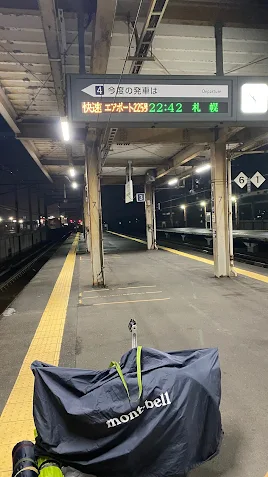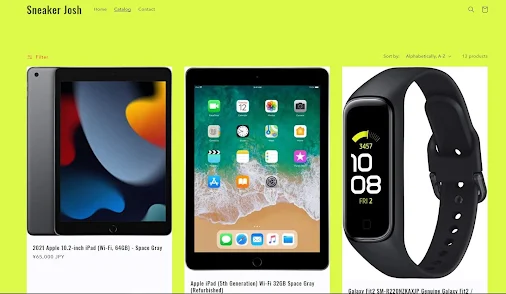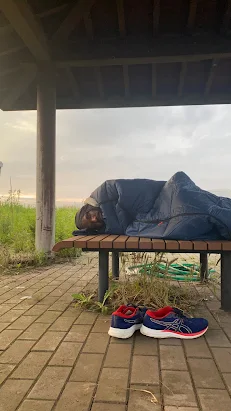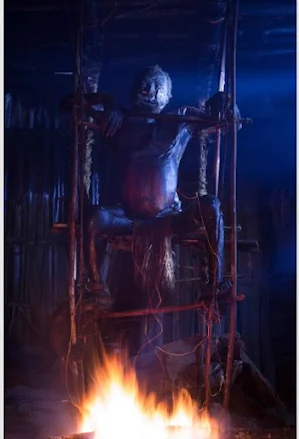This blog provides biking tour stories in Japan from a cyclist's perspective. Experiencing unique Japan through pure biking power.
Monday, 31 October 2022
Hobara town in autumn
Monday, 24 October 2022
Part 6: New Chitose to Sapporo.
New Chitose station.
I reached Chitose station at 10:15 pm. The last train leaves around 10:30 pm. I quickly dissembled my bike and packed it into my bike bag. Then brought it to the New Chitose train station's platform and waited for the rapid service train to arrive from New Chitose Airport. The rapid service train only makes 6 stops before reaching Sapporo. Because it's a rapid service train it takes only 45minuites to travel for 60 km while local trains take almost 2 hours for the same distance because they have to stop at each station along the track.
When the rapid service train arrived from New Chitose I brought my bike on the train and placed it at the door. There are not many spaces for large objects like bikes on trains in Japan. However, at the entrances of the trains, there are spaces big enough to keep bikes. In Japan, bicycles are allowed on the train. However, you have to put them inside bike bags. Specialist bike shops sell portable bike bags so you can buy one from these shops.
The rapid train left Chitose station and we made 6 more stops before arriving at Sapporo station around 11:30pm. I came off the train with my bike bag hanging from my shoulder and went out the north ticketing gate before existing Sapporo station through the north exit.
After exiting through the north exit. I placed my bike down in front of Sapporo station's north exit and quickly assembled my bike. After finishing assembling my bike I cycled to my partner's home which is 5 blocks from Sapporo station
At this point, my excitement to see my partner was so overwhelming for I moment I forgot that I actually just completed more than 600km of cycling and 100km of Ferrying to reach Sapporo. When I reached her home she was waiting for me in front of her apartment. She was so excited to see me. We hugged, and greet each other. Then we went together parked my bike and went home.
Waiting for the rapid service train to Sapporo at New Chitose Station.
Sunday, 23 October 2022
Part 5: Tomakomai to New Chitose
To Sapporo, Here I come.
The night was fine and warm as I descend from the Sliver ferry and rode off. It was raining 3 hours earlier while we were sailing past the tip of Aomori but for now, the rain has stopped and the night was perfect. Hokkaido's weather is unique from the rest of Japan. It is usually cold on summer nights. However, tonight was just perfect for cycling.
Before I started this trip. I planned to continue cycling to Chitose city when I get off the ferry at Tomakomai. Chitose city is between Tomokamo city and Sapporo city. In fact, its 28 km northeast of Tomakomai and 45km southeast of Sapporo. To get to Chitose city I have to cycle for at least 25km through the New Chitose airport.
New Chitose airport is the main airport for the Hokkaido area. I remembered 2019 when I first landed at New Chitose airport. I was taken aback by the unique designs of the airport and the environment around the airport.
To get to New Chitose I have to take route 36. Route 36 starts at Hokudai and goes to Sapporo city. So, I followed the port road out of Tomakaomai port and crossed onto route 36. Then I took route 36 northbound.
While halfway through my cycling it started raining. I took a shortcut to avoid the heavy traffic on route 36 due to the rain. The shortcut took me through the back of New Chitose airport before backing onto route 36.
I went through forested areas and it was dark. I have to use two flashlights to cycle. There were fewer cars on that road and less number of houses, too.
I continue cycling on that route for almost 2 hours before I saw a sign board that say. Go straight is Sapporo, Turn left is New Chitose airport.
I took the left and headed for Chitose city station. This time I crossed into a route that is a little busy. Big trucks were driving past me at high speed. Most main highways in Japan are very spacious.
Unlike in Papua New Guinea where the main highways are only built for cars and trucks, and if you are on the highway by foot or bike, your chances of getting run over are 80%. In Japan, the road is designed well to accommodate pedestrians, cyclists, animals, and even roadside emergency stops or parking.
Anywhere, it was still raining. But at this point, I did not care about the rain anymore. My excitement about getting to Sapporo is overwhelming. So, I cycled with all the power I I have. I have to reach New Chitose station in time for the last train.
New Chitose station entrance
Wednesday, 19 October 2022
How to shop online?
Online Shopping Tutorial for beginners.
1. Accessing online shops.
3. Searching for products.
4. Buy button
5. Using other payment gateways.
6. Confirmation Email.
Some important tips.
- You need a credit card to do shopping online.
- You also need to use the `currency calculator ` to know how much are you buying the product in your local currency.
- The shipping cost is separated and will be displayed in the cart as item cost + shipping
- Sneaker Josh will use DHL and you will receive your item in less than 7 days.
Check out Sneaker Josh Online shop.
Click here.
Monday, 17 October 2022
Part 4. Hachinohe to Tomakomai by Silver Ferry.
Overnight in Hachinohe.
It was already dark when I reached the Hachinohe ferry port. While cycling through Hachinohe city I took a quick glance at the google map and saw there is a Lawson convenience store on the junction leading into the ferry port. When I was about to reach the ferry port my eyes got sight of a Lawson's convenience store. Hooo, this is the one I saw on google map earlier. I remembered.
I then headed straight for it and parked my bike outside. I walked into the shop feeling excited because I had just completed 100km cycling for 10 hours. I walked through the food aisles and collected the foodstuffs like a king. Later I went to the checkout. At the checkout, I could not hold my eagerness to tell the store clerk about my trip. I said in Japanese. Even though my Japanese was not good I went ahead and gave my best shot.
こんばんは。 わたしは せんだいに いきました。 わたしは じてんしゃで いきました。 あつい コーヒーを のみます。 だから、からだは あたたかいです。
After having a conversation with the store clerk. I paid for my dinner and left. I bought a packet of bread and a cup of coffee. I then remember I still have a can of fish in my bag. I took it out, opened it and emptied it onto my bread, and ate while drinking my warm delicious coffee.
I recommend you buy coffee from a convenience store whenever you travel. The convenience store's coffee is delicious and comes in different flavors and sizes. But that's not all, the best part is, you can add any amount of sugar and milk you preferred.
While I was standing and eating I looked toward the northern corner of my eyes. There I saw the ferry port and just opposite the road from Lawson`s convenience store is Hattaro park. In fact, Hattaro park is part of the Hachinohe ferry port. It is basically the front extension of the port towards the main road.
Hattaro park is where I am staying for the night. The park is part of the port. There are no trees in this park. There are few benches in the park but are in specific sections of the park. The middle of the part is covered with a soft algae-like carpet. I think the algae grew and covered the middle ground in the park because of the Hachinohe`s summer. Summer in Japan is hot and humid therefore giving the algae a suitable condition for them to grow in abundance.
Toward the eastern end of the park are the toilet and a small shelter with a table-like bench in the middle of it. I did not have the chance to see the park clearly when I arrive because it was dark. I saw the whole park the next day in the morning.
Looking for shelter.
Around 9pm that night I crossed over to the park from Lawson convenience store and started searching for the shelter. I only saw the pictures of the shelter on google map so at this point I am not sure if it is still there or not. It was dark so I could not see where the small shelter is. For a good number of minutes, I searched for the shelter. I was looking at the wrong end of the park.
Finally, I decided to check the eastern end of the park. As I cycled toward the eastern end of the park. Through the dark shadow of the night, I can see what appears to be a small shelter. As I got closer I realized it was the shelter I am looking for. Then just a few meters to the right of the shelter I saw the toilet as well.
The toilet and the shelter are at the end of the park where there are no lights. Both are only made visible by the dim lighting from the nearby port facilities. I was so happy because this is where I am going to sleep tonight, right on the shelter's square bench.
I parked my bike and unpacked my sleeping bag. The night's weather was warm. Warm breezes blew in from the Pacific ocean. I decided not to use my tent because it was warm enough to just sleep with my sleeping bag. By the way, there are no mosquitoes to worried about.
My sleeping bag is a Colman 200cm x50cm sleeping bag. Fit for all weather conditions. I bought it for 5,000 Japanese yen(K150). Tonight I will test it and see if the price is worth the money. I spread my sleeping bag on the bench and tried it out, and it was perfect. All my doubts regarding the sleeping bag are gone. The inside of the bag is soft and warm. It`s also very spacious inside.
Before going to sleep I quickly went to the toilet, relieved myself, and then made a video call to my partner in Sapporo. Letting her know that I'm at Hachinohe ferry port and tonight I am sleeping under an open shelter in my sleeping bag at Hattaro park.
After the call, I crawled into my sleeping bag. It was warm and comfortable. I pulled it up over my head and within minutes fall asleep.
Silver Ferry can be seen in the distance docking on the other side
of Hattaro Park.
Silver ferry.
Japan is a very scheduled society. Everything has to be planned in advance. Things like holidays, plane tickets, and hotels have to be booked and paid for in advance at least a month earlier. I booked my ferry for at least a week before cycling to Hachinohe to cross to Tomakomai.
My Silver ferry was scheduled to leave at 11 am the next day. By the time I woke up around 7am the Silvery Ferry was already docked at the port. The morning was cloudy and dull. A bit cold too. I did not want to get out of my sleeping bag because it was warm and comfy inside. But at the same time, I was so excited. In my life, I traveled on ferries only a few times, less than 5 times I guess. So, this was the most exciting day for me.
After waking up, I washed my face at the water tap next to the shelter and crossed over to the Lawson convenience store for a delicious cup of warm café latte. The café latte made my body warm and my sleepiness was gone. Now, I am ready to kick-start my day. After having the café latte I went to the Silver ferry's ticketing office. Parked my bike at the building's entrance, went inside, and waited for the ticketing office to open.
While waiting for the ticketing office to open the clouds opened up and it started raining. I thought, man I hate the rain. But for now, I am safe inside the Silver ferry`s ticketing office. The counter usually opens at 9am.
When the counter opened at 9am I went and showed my booking reference number to the lady at the county. I also can`t hold my eagerness to tell her my story. I said in Japanese .`Hey, guess what? I cycled 600km to get here. I am going to Sapporo. Look!, that is my bike`, pointing to my bike parked outside through the glass window of the building. She said something in Japanese which I don`t understand but I can see her face`s reaction. She was amazed.
She proceeded with my ticket and gave me instructions to bring my bike to the ferry early. The only problem is she said every in Japanese but I did understand a little bit. I went too early to the ferry port and waited. Wrong move.
As I was waiting the rain poured on me like cats and dogs. I wore my raincoat so my body was not wet but my shoes and socks were soaked in water. My feet were wet, cold, and terrible. I stood there in the rain for what seemed like hours because I lost count of time. I just wanted to get on the ferry and get to Sapporo.
All aboard.
I boarded the Silver ferry at 11:30am after all the trucks have been loaded into the ferry loading area. I boarded through Silver ferry's main loading door. After entering the main loading door. A loading crew took my bike and tied it to the side support rail. A Silver ferry's crew came and led me to my cube in the second class of the Silver ferry.
The cabin crew led me through a narrow stairway from the loading area up to the first floor. Then we entered the Silver ferry's main lobby. It was spectacular. For a moment my mind switched to Titanic's main lobby where Jack was waiting for Rose at the bottom of the staircase. It looks kind of similar.
There are also a few expensive pieces of jewelry on display in the lobby. The most spectacular one was a diamond neckless. Secured in a solid glass display. Wow! sparkling, I thought as we passed it.
We then climbed up another staircase and arrived at the top floor. The crew then led me into a corridor that looks like a hotel corridor. Then he opened the second door to the right and led me to my cube. There is a total of 10 cubes in one room. Each cube has a double bunk bed. The double bunkers have their own light, curtain for privacy, charging port, futon, bed sheet, billow, and a coin locker.
I never experienced such a relaxed private space on a ferry before. The last experience I had with a ferry was in 2005 when I went to Vanimo. A small town on the northern land border of Papua New Guinea with Indonesia. I slept on the back deck of the ferry under a bench next to a bunch of piled wet ropes and watched the ferry`s propellers make waves.
After the ferry crew left I quickly unpacked my stuff, removed my wet-socked shoes, and jumped straight into the bed. I went outside on the deck one or two times to see the ocean. But for the rest of the trip, I slept. I had to have a good sleep because I still have 75km left to cycle after I get off the Silver ferry.
The ferry trip from Hachinohe to Tomkomai took 8 hours. I was so eager to get to Sapporo. So, the 8 hours of doing nothing feel not right.
I checked my GPS navigation app and it showed the Silver ferry is traveling at a speed of 80km -100km per hour on the open sea. We went past the Tsugaru Strait. It is the sea between Aomori, the North part of Japan's main island, and Hokudate, the Southern tip of Hokkaido Island.
Silver Ferry`s Second class cubical.Getting Off Silver Ferry.
At 8:30 pm Silvery docked at Tomakomai city`s ferry port. Tomakomai city is a port city located on the southeast end of Hokkaido towards the Pacific ocean. A fairly large city consisting of port industries and services.
Once the final departing call was made on the Silver ferry PA system. I packed my stuff and left my cubical. I usually bring minimum stuff when cycling, like today in my backpack, I have my wallet, 2 power banks, one extra shirt, and chocolates.
I left the cubical and went down to the loading area of the ferry. Following the same way I came. I went through the lobby, past the ferry's canteen, and then took the left stairway which took me to the staircase leading down to the ferry's loading area.
The ferry has two loading areas for cars and trucks. The first loading area is at the bottom of the ferry and the second is above the bottom loading area. My bike is at the second loading area. When I reached my bike after coming down from my cabin I untied my bike from the side rail and waited for 10 minutes for the main door to open. When finally the door opened I was given the go by a loading crew. So, I jumped on my bike and rode off the Silvery onto Tomakomai port.
Monday, 3 October 2022
The Mummies of Aseki in Papua New Guinea .
The mummies.
Mummies; Egypt, pyramids, dead bodies, old bandages, coffin boxes, tombs, pharaohs, these are the words you might be thinking of when you see the word mummies. Because this is how it is shown in movies, right.
Well, what if I told you that there are also different kinds of mummies. Your reaction would be, 'really!'. And, what if I told you they are not to be found in Egypt only. You would think, am I lying, right.
But, Yes that is true. There are other mummies and in Papua New Guinea there are mummies too. Real mummies.
In Aseki, a district in Papua New Guinea mummification is part of their burial rituals for generations. The way they mummify their dead is different from the Egyptians. The Ancient Egyptians removed the dead's organs, and let the inside dry. They keep the organs inside a jar and leave the body for up to 40 days before it is filled with sand and wrapped with bandages.
The mummies of Aseki are different and interesting. Read on to know why?
Photo by Tia Ghose,2015.
The mummies of Aseki
Photo by Ronald and Andrew,2015.
The Mummies of Aseki.
Where is Aseki?, and why do they practice the art of mummifying their death?
Interesting, right.
Aseki is a district in Papua New Guinea, a fringe highlands region that is somehow a little detached from the ideas of the modern world. Sometimes usual things like mists may be considered omens from the spirits. Here the idea of the modern world is something misunderstood by the ancient world. Kind of bizarre, right.
Well, wait until you hear about their mummies.
How did they select the mummies?
In today's modern context. The influences of Christianity and globalization have changed a lot of tribal cultures. However, the likely person to be mummified is the tribal elder.
In the past, mummification is done on every member of the tribe. That includes women and children.
Photo by Ronald and Andrew,2015.
The mummification process.
Today, mummification is a little different. It is not the same as what their forefathers practiced. Due to globalization, young people are becoming less interested in mummification rituals and more focused on business, work, schools, and modern life.
However, despite the modern ways of today. Most elders dying wish is to be mummified. The process takes time and a lot of planning so elders who want to be mummified after he /she departed have to inform the son of their dying wish. The process is long and during the process, people have to remain with the dead body.
PHOTOGRAPH BY ULLA LOHMANN
Mummification of a tribal elder.How are the mummies made?
The process takes time and careful handiwork of the mummy makers to make the mummies more lively.
Before the mummification ritual process begins some initial preparation has to take place. A smoking house has to be built and the body has to be positioned on a smoking chair. The smoking chair allows the body to be placed over the fire for the smoking and mummification process to take place.
The body of the tribal elder who has departed is taken to the smoking house by his sons and other young male tribal members. The smoking house is where the actual mummification ritual takes place. The body is suspended over a fire and smoked. The mummy is made by smoking the body. Mummy makers stay with the body and continue the rituals for days.
But you might want to know how they deal with body fluids and organs.
The bloated body's fluid is drained through billing holes using sharp bamboo sticks to remove the body fluid. To remove the organs the anus is expanded using bamboo sticks and the organs are removed. Once the body is smoked, the body is then covered with ochre clay. The clay is also part of the rituals but it also serves as a medium to wick additional moisture from the body(Ronald and Andres,2015).
The important part of mummification is to keep the face intact. The local tribe believes that this will allow the spirit to find its body at night time to rest. Because during the day the spirit leaves the body and goes outside.
The entire process takes up to a month. Once it is done, the mummy is placed on the side of the rock with its smoked chair. This will be its resting place.
PHOTOGRAPH BY ULLA LOHMANN
PHOTOGRAPH BY ULLA LOHMANN
The cultural significance of mummies.
The mummies are a way for the living to connect with their departed loved ones and ensure that the departed are not forgotten. It also symbolized good luck and protection from bad omens.
It is a very unique culture that is still practiced today.
Reference.
Daniel Stone, National Geography, October 5,2016.
Link. https://www.livescience.com/50948-photos-smoked-mummies-papua-new-guinea.html.
Why is Japanese English Efficiency level very low compared to other developed nations.
Why Does the English Education System in Japan Fail to Create English Speakers? Let’s dive into the topic of English education and its overa...

-
Three of my favourits pickup trucks Many of you have seen or have driven at least one of these famously known pickup tricks from the Toyo...
-
My Challenges and Struggles of Living in Japan as a Foreigner. I’ve been reflecting on my life in Japan and wanted to share some of the chal...





































.JPG)



















